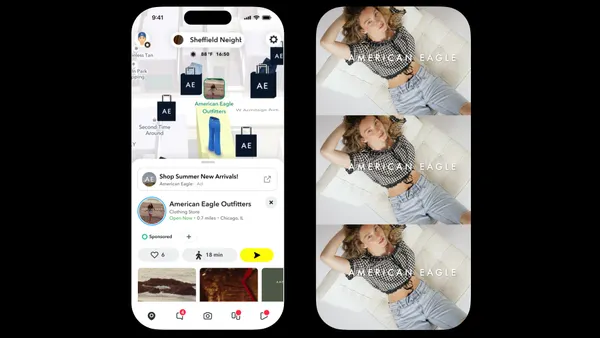A lot has happened in a year — and we're bringing back all of the best (and by that we mean worst) retail trends and travesties from a year that started with a deep love for Costco's Kirkland-brand golf balls and ended with $400 Star Wars memorabilia.
We know it can be exhausting to follow retail's oddities, week in and week out, but that's why we do it: so you don't have to.
So sit back as far as your airline-assigned seat will recline, relax as best you can and get ready to relive some of 2017's worst retail moments.
6. Take cover! The overpriced objects are coming!
Fashion can be controversial, but it seems there's one thing we can all agree on: there were way too many everyday objects parading as high fashion this year.
From Balenciaga selling $795 tennis shoes (or, we should say, Balenciaga selling literally anything) to Neiman Marcus asking wealthy spenders to shell out thousands of dollars on "delightfully over-the-top finds" and Williams-Sonoma following suit with a holiday catalog that lauded $250 "stylized horse objects," of all things, there was no shortage of ridiculously priced merchandise this year.
In a move that seemed to take inspiration from Prada's $185 paper clip — an equally absurd product that sent the internet into a tailspin back in June — Tiffany's aptly named "Everyday Objects" line took a host of commonplace items (think $575 paper cups, $1,500 coffee cans and $275 pencil sharpeners) and transformed them into overpriced commodities. Because nothing says "status symbol" quite like a $9,000 ball of yarn.
This shit better hold my whole life together y'all. https://t.co/HH0bUpsmKu
— Kim Thai (@kkimthai) June 23, 2017
Prada is selling a $185 paper clip and it doesn't even help you write a resumé. pic.twitter.com/sLEjKRKM1o
— Matt Fernandez (@FattMernandez) June 24, 2017
We had to laud the diversity of Tiffany's collection, though: it really did have gifts for every member of the family. A $450 razor for dad, a $10,000 decorative bird's nest for mom, a $300 yo-yo for the kids and — what every high schooler enrolled in geometry wants for Christmas — a $425 protractor. Not to mention a $275 magnifying glass and a $950 candlestick, perfect gifts for the office or the in-laws.
No doubt, every object included some combination of silver, walnut and turquoise — as well as a healthy dose of pretension and the high possibility of buyer's remorse.
Tiffany is selling a can for $1,000.
— Jennifer Wright (@JenAshleyWright) November 7, 2017
In other news, I now understand why people stormed the Bastille.https://t.co/Gq3pNxjySJ
for christmas this year I'm getting everyone the everyday version of tiffany's everyday objects
— camille c.a (@chesdre) November 8, 2017
"We need something for the person who has everything"
— Chelsea Kiene (@chelseakiene) November 7, 2017
"A tin can, but made of sterling silver & vermeil"
"Brilliant"https://t.co/lo1pgadeD8
5. Monoprix spoiled Amazon Go's spotlight
If Amazon is the bully on the retail playground, then French grocer Monoprix is the smug kid who publicly embarrasses them in the climax of the film.
Back in December 2016, Amazon released a Youtube video describing what it believed to be a futuristic, industry-shattering service poised to eliminate the very thing customers hate most about shopping — actually checking out. Some in the industry were awed by the tech's potential to redefine physical retail — but others? Not so much (And can you really blame them considering the big tech hiccup that's been holding up a roll out?)
In an ideal world, here's how Amazon hopes we all shop someday.
In the real world, Monoprix said its customers already do shop like this, to some extent. In a pithy jab at Amazon, the grocer published an almost frame-by-frame parody of Amazon Go's so-called earth shattering video, featuring its own decade-old service, "Livraison à domicile +," which allows customers to shop in-store and have groceries delivered to their home within an hour, GeekWire reported.
Turns out Amazon's script wasn't safe either. "Over 10 years ago, we were wondering what would shopping look like if you could walk into a store, grab what you want, and just go?," the video quipped. Sacré bleu!
Chez Monoprix, vous pouvez faire vos courses sans passer par les caisses... depuis 10 ans #MonoprixLivraisonPlus pic.twitter.com/8lMpUZbF0f
— Monoprix (@Monoprix) December 20, 2016
@Monoprix shows @amazon up w/ the #frenchtouch through #AmazonGo parody! Clever #storytelling #monoprixlivraisonplus https://t.co/OA1e154l34
— Thibaut Patelli (@TPatelli) December 21, 2016
Brilliant #MonoprixLivraisonPlus store takes piss out of #AmazonGo Had to happen https://t.co/AoSZwGT5O5
— Howard Saunders (@SaundersHoward) December 27, 2016
July was also a bad month for Sam's Club, who chose — for some unknown reason — to release a pool float that looked way more like it belonged in an Always box than in the pool float aisle of a warehouse retailer. The poorly thought-out product left Sam's Club to suffer the wrath of women on Twitter who were quick to point out that the woefully ignorant product could have been saved with the help of a focus group including people who have actually seen a maxi pad in real life.
What went wrong, Sam's Club?
Focus group. This could have been avoided with 1 focus group (of women). pic.twitter.com/C76lv5ji33
— Jillian David (@JillianDavid13) July 3, 2017
To Hell with it - let's complete the theme and have a pool noodle that looks like a tampon.
— Kirsten R. (@kelisabeth38) July 5, 2017
If you don't want to lose this on the pool deck, just pull off the adhesive strip on the back and attach it to your chair!
— Becky McG. (@bmmcgar) July 3, 2017
4. Stranger Things happened
They say a picture is worth a thousand words, but what they don't tell you is that a hit Netflix series is worth a hell of a lot more. Like, for example, $400,000 of sales — in one afternoon — for a brontosaurus sweatshirt.
The beneficiary? The Science Museum of Minnesota. The popular Midwestern attraction hit the pop culture gold mine back in October, the Star Tribune reported, when Stranger Things came out with a second season that had one of its leading youngsters sporting a 1980s-style hoodie with a brontosaurus and "thunder lizard" printed on it.
According to the report, the museum was flooded by so many requests to buy the sweatshirt that they finally decided to stock it in November, fulfilling the dreams of every child (or adult) looking to emulate the fashion choices of a middle school boy. The product description urged customers to "turn your world upside down with our vintage Brontosaurus apparel," with one important caveat: "Walkie talkies not included."
And the best part? Shoppers didn't have to take on a demogorgon to get it — just a few long lines.
— Star Tribune (@StarTribune) November 7, 2017
YES!!! it has arrived!! @sciencemuseummn #StrangerThings2 #ThunderLizard @Stranger_Things pic.twitter.com/iaioscjyjW
— Mrs. L (@EvilAngel1679) November 15, 2017
I think I helped break @sciencemuseummn! Sorry! #strangerthings #thunderlizard pic.twitter.com/ZnDQtzVwi5
— Shanan Custer (@ShananCuster) November 7, 2017
3. Denim-clad disasters
There was so much bad denim this year that we're not even sure where to start with this one.
Nordstrom, however, was one of the worst offenders — which comes as no surprise considering the retailer topped our roundup last year with an $85 rock.
The department store retailer decided we all needed clear-knee mom jeans when really we didn't need clear-knee anything. Just a month later, the same retailer started selling a pair of $425 mud jeans that looked like they were pulled out from a manure-filled dumpster outside of a rodeo. Suddenly by October it was high fashion to wear jeans that consisted of just the seams.
And that's not even the half of it. This year also brought us detachable jeans, which buttoned off into a denim diaper; double waistband jeans, which cost more than two Amazon Echo's; and some form of denim skort, courtesy of Asos (which probably showed up in retail therapy more than any other retailer this year).
Much like analysts that cover Sears, we're running out of negative adjectives to describe the denim products retailers are producing.
ROMPERS: we are the stupidest fashion trend of 2017
— Andy H. (@AndyAsAdjective) May 18, 2017
DETACHABLE JEANS: hold my beer... pic.twitter.com/yr1YpXjL8d
Get those @Nordstrom @Topshop #clearkneemomjeans ($95 online) w/ Mom jeans ($7.94 at thrift store) & a shower curtain ($FREE from my HAUS). pic.twitter.com/my2QLbHagI
— Tom Lenk (@tomlenk) March 14, 2017
Thong jeans now exist so let's officially get the apocalypse rolling pic.twitter.com/V9y5eA5LsQ
— Oksana Vig (@OksanaVig) October 19, 2017
2. Plastic bags became a high fashion craze
In late April, Ikea — best-known for selling Swedish meatballs and do-it-yourself furniture — fell headfirst into the world of high fashion. Luxury handbag maker Balenciaga paid homage to Ikea's iconic, oversized reusable "frakta" bag, most commonly used for stowing household essentials while traversing the furniture retailer's warehouse.
The "Arena Extra-Large Shopping Tote," which was being sold online at Barney's for $2,145, sparked a fascination with consumers. The only problem was that most couldn't afford the hefty price tag — and why should they when they could pick up their own frakta bag for just 99 cents a pop?
Instagram exploded with photos of do-it-yourself high-fashion apparel and accessories made from frakta bags. Here's a look at some of the most "creative" designs:
Apparently flattered by the social media craze, Ikea responded to the hype later that week. "We are extremely flattered to seemingly be an inspiration for the latest catwalk designs. Our IKEA FRAKTA tote is one of our most iconic products which are already owned and loved by millions," a spokeswoman told HuffPost UK.
But what seemed like an isolated incident grew into somewhat of a trend for Balenciaga, with the retailer selling a luxury version of its own free shopping bag in July... for $1,819. And that was after they had already seen success selling a luxury version of their white paper bag for $1,100.
Somebody tell Kroger to up the prices on its plastic shopping bags — they're clearly not getting enough for them.
Balenciaga's $1,100 shopping bag is already sold out pic.twitter.com/QIhs2zs23P
— TBlake (@therealtblake) June 21, 2017
This one is thick paper but at least it was free pic.twitter.com/PGHtlPRiEF
— Kyle Janko (@Kyle_Janko) June 21, 2017
1. The great Unicorn Frappuccino flop
Also in April, Starbucks released a flavor-changing "unicorn" drink that apparently looked a hell of a lot like Lisa Frank threw up in a cup. Worse, many reviews said it didn't taste much better than it looked. The drink was made with a "sweet dusting of pink powder" blended into a creme Frappuccino with mango syrup and layered with "pleasantly sour blue powder topping," according to a company press release.
Initially, the drink stirred up excitement from consumers eager to taste the "color-changing, flavor-changing totally-not-made-up-limited-time-only Unicorn Frappuccino." But after participating locations began serving the "magical" beverage, intrigue quickly turned to indignation for some Starbucks baristas.
One employee posted a video on Twitter ranting about how terrible both the craze and the drink itself were. "Please don't get it!" Braden Burson, a Colorado Starbucks barista, said in the video. "I have unicorn crap all in my hair and on my nose. I have never been so stressed out in my entire life."
Starbuck's liquid failures continued with the Ombre Pink Drink, the Midnight Mint Mocha and, of course, the Christmas Tree Frappuccino, none of which seemed to inspire particularly positive reactions from fans and especially not from the staff, who could be described as "grudgingly obliging" at best.
Mostly Starbucks baristas seem to have spent this year hoping the limited-edition drinks would make like a unicorn and magically disappear.
As a barista, just know that every time you ask me to make this, a part of me dies #unicornfrappuccino
— Tina Dee (@fairlyfamous) April 19, 2017













